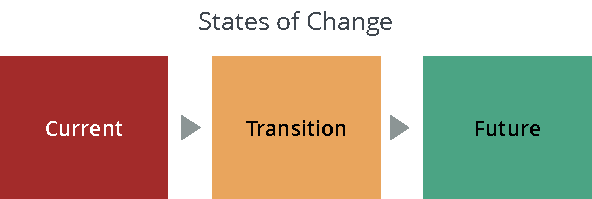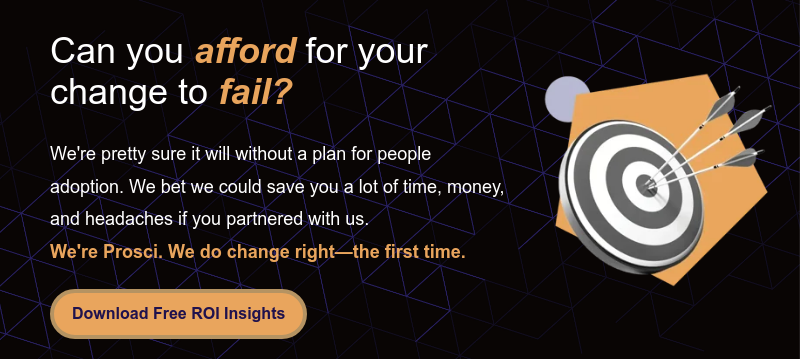Change vs. Change Management

4 Mins
Updated: October 28, 2025
Published: March 3, 2021

Change and change management can seem interchangeable in organizations, but there are significant and important differences between the two. And when there is no clear delineation, people can lack clarity about what is needed to move a change initiative forward. The better we separately define and address change and change management, the better position we will be in as change management practitioners—with a clearer scope, and shared direction and purpose.
Difference Between Change and Change Management
Although change is about moving to a future state, change management is about supporting employees impacted by the change during their individual transitions from their current state to their future state. Let's look more closely at the differences between change and change management.
Change is...
Change is a movement out of a current state (how things are today), through a transition state, and to a future state (how things will be done). This concept of three states of change is prevalent in change management literature and other improvement disciplines.
Change happens all around us: at home, in our community, and at work. Changes can be internally motivated or externally motivated. The change can be a dramatic departure from what we know or it can be minor. Change can be anticipated or unexpected.
Typically, we take an organizational perspective when talking about change:
- Moving to documented and managed processes from ad hoc processes
- Moving to an integrated system from numerous legacy systems
- Merging two organizations
- Introducing a new product to the market
- Introducing new equipment into the manufacturing processes
- Moving to call center specialists from a generalist model
Each of these examples has a clear current state and a clear future state. When we undertake a project or initiative in the organization, we provide structure to the effort of designing the future state and developing a solution for the transition state.
However, every organizational change has individual impacts on the tens, hundreds or thousands of employees who have to do their jobs differently when they adopt the solution. This is where change management comes in.
Change management is...
Change management is about supporting people through their individual transitions. Change management is necessary because organizational change—moving from an organizational current state to an organizational future state—ultimately impacts how people do their jobs (likely many people).
- Someone executes the newly documented and managed processes
- Individuals accesses the new integrated database
- Employees in the newly merged organization must work differently
- The new product impacts how someone does their job
Although change is about moving to a future state, change management goes further by supporting employees impacted by the change through their transitions, equipping and enabling them to move from their current state to their future state.
 Some employees will rapidly engage with the change. Others will be reluctant. Some will be happy with the change and others will be upset by it. Some employees will change quickly, others may take some time, and there may be a group that will not adopt the change at all. Change management provides the process, tools and principles to support the individual transitions precipitated from an organizational future state.
Some employees will rapidly engage with the change. Others will be reluctant. Some will be happy with the change and others will be upset by it. Some employees will change quickly, others may take some time, and there may be a group that will not adopt the change at all. Change management provides the process, tools and principles to support the individual transitions precipitated from an organizational future state.
The connection between "change" and "change management" can be characterized as follows:
The changes in our organization create new future states for how we operate. To reach those future states, individual employees have to do their jobs differently. Achieving the desired, organizational future state depends on the success of individuals reaching their personal future states. Change management is the structured and intentional approach to enabling individual employees to adopt the changes required by projects and initiatives.
The point here is that when results and outcomes of a project or initiative depend on employees adopting the change and doing their jobs differently, change management is essential for delivering those results and outcomes.
How To Eliminate Confusion
Follow the steps below to clarify confusion about the differences between change and change management.
1. Identify the confusion
Are you experiencing this confusion with anyone you are supporting? In your work, have you seen confusion or lack of clarity about change and change management? If so, who are you seeing the confusion with?
- Project leaders and teams
- Solution designers and developers
- Executives and senior leaders
- Other change management practitioners
- Other stakeholders
2. Use the states of change
Introduce and position change management by describing the states of change at both the organizational level and the individual level. Start the conversation about the current state, transition state and future state. And then continue the conversation to focus on individual current states, transition states and future states.
To illustrate this clearly for others, ask them to do a basic exercise. On a sheet of paper or whiteboard, make two columns, Now have your audience (project team, senior leader, etc.) define the future state of the organizational change on the left side. On the right side, have them define five specific individual future states that the change will cause.
3. Ask a simple question
Introduce the notion of change management by asking a simple yet compelling question: Who will have to do their jobs differently as a result of this project or initiative? This is the beginning of the process of segmenting out the impacted groups, so you can address them specifically from a change management perspective. By asking and helping to answer the question, you are establishing a working relationship with the project team, which provides a solid start for your change management work.
Prosci's framework for connecting people to business results is called the 4 P's exercise. To try it, create four columns on a sheet of paper or whiteboard, and label them as Project, Purpose, Particulars and People. Under the Project column, write the name of the project. Under the Purpose columns, have team members list the reasons for the change. Under Particulars, ask team members to detail the specific changes to processes, systems, organization structures, etc. resulting from the project or initiative. And under the final column, People, ask the team to list the individuals and groups who will do their jobs differently after the project. Finally, use the content you created as context for discussing the connection between your project changes and change management.
Change Management Is Not the Change
When people and teams can't distinguish change from change management, your efforts to move your initiative forward can stall. Taking simple steps to clarify the differences in your organization highlights the benefits of change management, enables greater buy-in and support, and sets you up for greater success with change.




